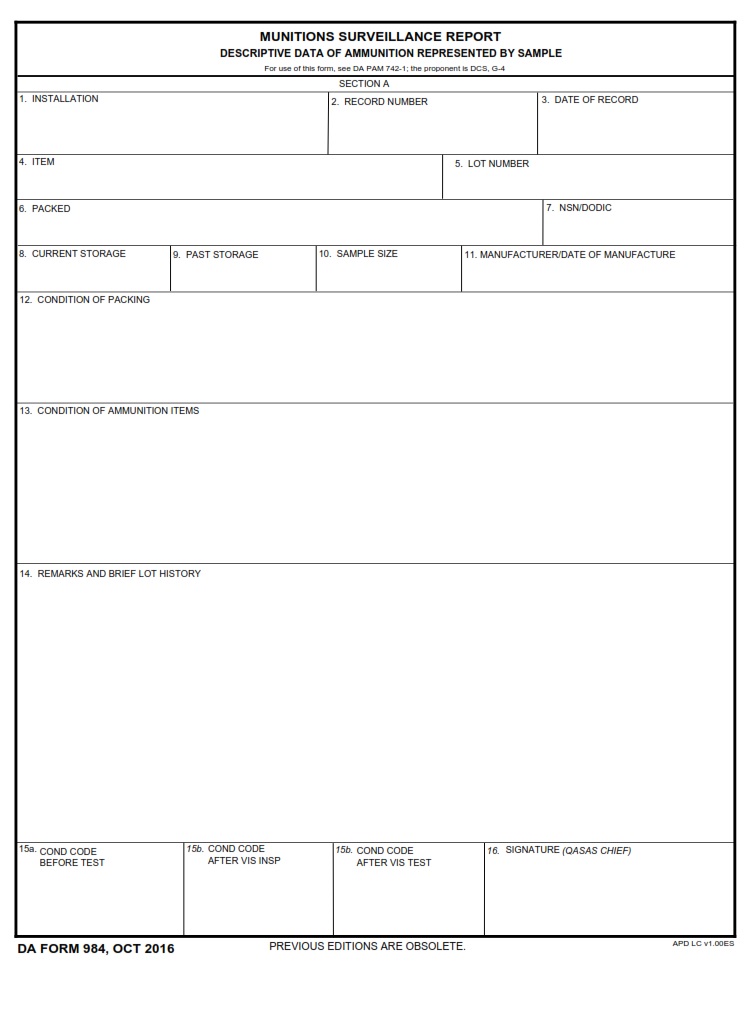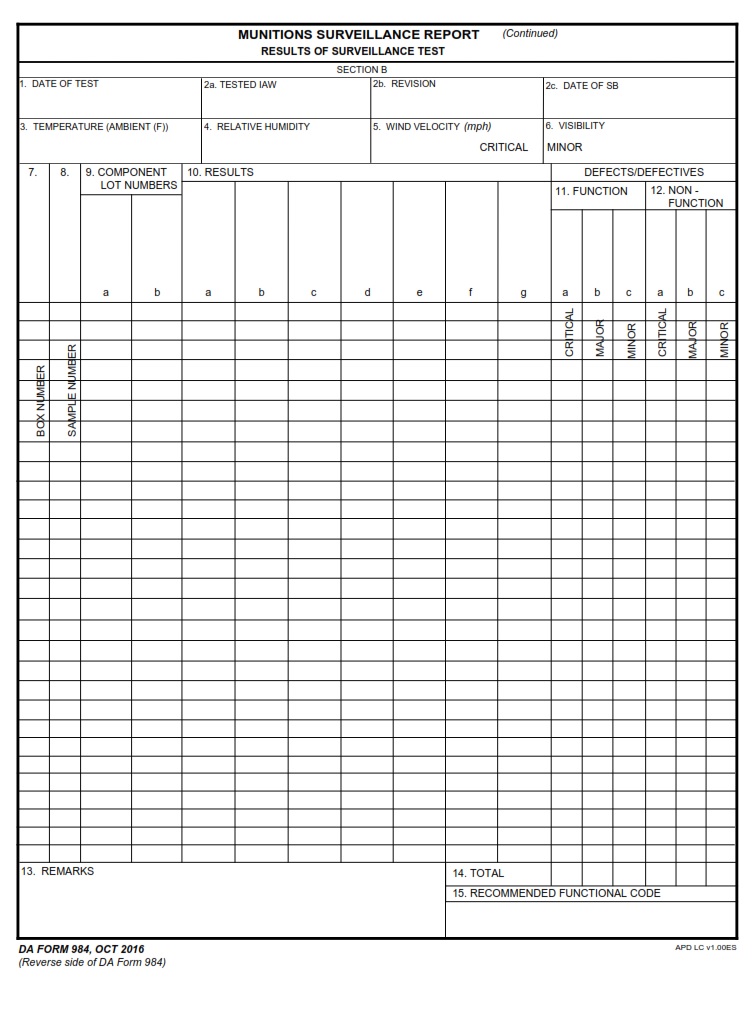Table of Contents
FREE-ONLINE-FORMS.COM – DA Form 984 – Munitions Surveillance Report – Have you ever wondered how the military keeps track of its munitions to ensure they are safe and secure? The answer lies in the powerful document known as DA Form 984 – Munitions Surveillance Report. This seemingly unassuming piece of paperwork holds immense importance in safeguarding our armed forces and preventing potentially catastrophic incidents. From tracking stockpile quantities to monitoring maintenance records, this report acts as a vital lifeline for munitions personnel, enabling them to identify potential issues before they become disasters. In this article, we will delve into the intricacies of DA Form 984 and explore how it plays an indispensable role in maintaining the integrity and readiness of our military’s arsenal.
Imagine being responsible for managing thousands upon thousands of explosive devices, each with its own unique maintenance needs and potential risks. It sounds like a daunting task, doesn’t it? Well, that’s where DA Form 984 – Munitions Surveillance Report comes into play. This deceptively simple-looking document is far more than just ink on paper; it is a comprehensive record-keeping system designed to keep our military’s ammunition at peak performance while ensuring utmost safety. In this article, we will take you behind the scenes of munitions management and reveal how this oft-overlooked form serves as a critical linchpin between life-saving accuracy and catastrophe-causing negligence.
Download DA Form 984 – Munitions Surveillance Report
| Form Number | DA Form 984 |
| Form Title | Munitions Surveillance Report |
| Edition Date | 10/1/2016 |
| File Size | 2 MB |
What is a DA Form 984?
The DA Form 984, also known as the Munitions Surveillance Report, is a critical document used in the military to ensure the safety and effectiveness of ammunition. It serves as a recording tool for personnel involved in handling and inspecting munitions, providing vital information on their condition and any associated issues.
One key aspect of the DA Form 984 is its ability to track trends and patterns regarding munition performance. By meticulously documenting each inspection and test result, this form enables military officials to identify potential problems or inconsistencies. This data-driven approach allows for targeted interventions to maintain high levels of safety and combat readiness.
Additionally, the DA Form 984 plays a crucial role in accountability and transparency within the munitions supply chain. By recording specific details about lot numbers, quantities, inspection dates, locations, and personnel responsible for handling munitions at various stages throughout their lifecycle – from receipt to disposal – this form ensures that processes are followed correctly and traceability is maintained.
In sum, the DA Form 984 serves as an invaluable tool for effectively managing munitions surveillance. Its comprehensive nature provides insight into any potential risks or issues with ammunition while promoting accountability within military operations. By utilizing this form appropriately, armed forces can optimize their ammunition inventory management systems to better serve their mission’s objectives.
Where Can I Find a DA Form 984?
If you’re in the military or work with munitions, you may be familiar with the importance of proper documentation. One crucial form that is frequently used in this field is the DA Form 984 – Munitions Surveillance Report. This form plays a significant role in monitoring and reporting any issues or discrepancies related to munitions storage, handling, transportation, and security.
So where can you find a DA Form 984? The most accessible place to obtain this form is through official military channels. You can start by reaching out to your unit’s supply sergeant or ammunition officer who should have copies readily available. Additionally, many military bases maintain resource libraries or online repositories where personnel can access various forms, including the DA Form 984.
Another option is to visit the official U.S. Army website where they provide several blank forms that can be downloaded and printed for use. Once you’ve obtained a copy of the form, ensure that it is an up-to-date version as older versions may not include all of the required information fields.
In conclusion, if you find yourself needing a DA Form 984 – Munitions Surveillance Report, there are several avenues available for obtaining this essential document. Whether it’s through your unit’s supply chain, online resources provided by military bases, or direct downloads from official government websites; ensuring accurate documentation and reporting within munitions operations is crucial for safety and accountability purposes.
DA Form 984 – Munitions Surveillance Report
One of the most critical forms used within the military is the DA Form 984, also known as the Munitions Surveillance Report. This form plays a vital role in ensuring that all munitions are properly inspected and maintained to achieve optimal readiness and safety levels. It serves as a documented record of any discrepancies or issues found during inspections, providing valuable information for maintenance crews and commanders.
The Munitions Surveillance Report goes beyond being just another bureaucratic document; it holds significant importance in identifying potential risks and preventing accidents or malfunctioning during munition handling. By carefully documenting any defects or deficiencies discovered during inspections, this form allows for timely actions to be taken to rectify problems before they escalate into critical incidents. Moreover, it provides clear visibility on specific areas that may require additional resources or training to prevent future mishaps.
In conclusion, while filling out paperwork may seem like a mundane task, in the case of the Munitions Surveillance Report (DA Form 984), it is an essential aspect of maintaining safety within the military. This form not only safeguards personnel but also ensures operational readiness by proactively addressing concerns related to munition quality and reliability.

